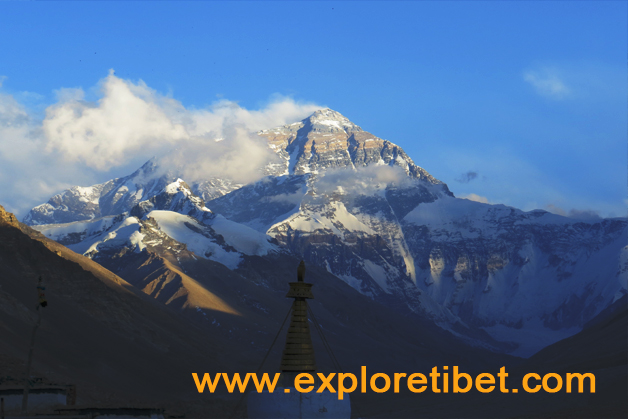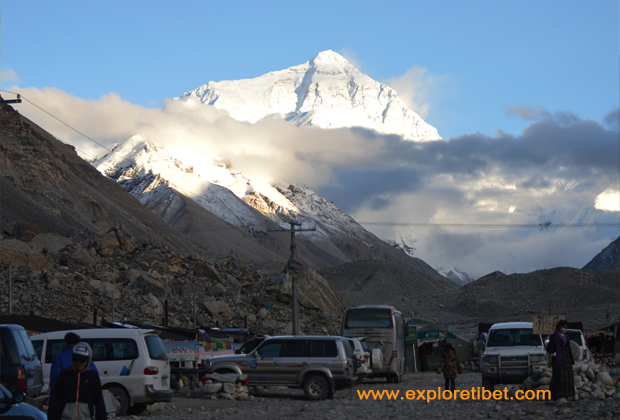Is it Worth Staying Overnight at EBC?
Mount Qomolangma, the Highest Mountain in the World. Standing 8,848 meters (29,029 ft.) above sea level, this massive peak is the premiere attraction of Tibet, lying on its westernmost border with Nepal. Around 18 kilometers to the north of the peak of this great mountain lies the famous Everest Base Camp in Tibet, the first of the base camps to be constructed at the foot of Everest. Known as EBC, this base camp is the target destination of thousands of tourists and travelers every year, itching to stand in the shadow of the famous mountain for selfies and kudos. For many travelers to EBC, an overnight stop is made, and you stay in tent guesthouse or the Rongbuk Monastery Guesthouse. But is it worth the risk of altitude sickness for an overnight stay?

Mt Qomolangma View from EBC
Will I get Altitude Sickness at EBC?
Many people ask this question, and the answer is a simple yes for some tourists. The ones that do require more concerned aid with Acute Mountain Sickness (AMS), also known as altitude sickness, at EBC are few and far between. For most tourists, only the milder symptoms will appear, if any. Not everyone traveling from Lhasa to EBC will feel the symptoms of AMS returning. For some, the stopover in Shigatse (3,900m) is enough to stave off further effects of altitude sickness when they reach EBC.
How to deal with altitude sickness at EBC?
Located at an altitude of 5,150 meters, the base camp is one of the highest points tourists can go to on the plateau and is a challenge of high altitudes and a decidedly harsh environment. AMS is one of the most common concerns when visiting EBC in Tibet. At its extreme altitude, altitude sickness is often a potential problem for those staying overnight at the base camp. While you may have spent a couple of days acclimatizing to the higher altitudes of the plateau in Lhasa, this is nothing compared to the extreme altitude of the base camp. And when you ascend once more by another 1,500 meters, you should prepare for the possibility of feeling the symptoms of AMS once again.
There are ways to deal with a return of altitude sickness at EBC. The first and foremost is the type of tour, and you should take a tour that ascends gradually, to allow you to acclimatize better along the way. You should also make sure that the guide for your tour to EBC is experienced in taking tours to the base camp and knowledgeable on the symptoms and aids for altitude sickness. Your guide can give you hints and tips on the best ways to help prevent it at EBC, as well as providing a caring and conscientious service to help you reduce the risk of AMS. And by simply remaining hydrated and refraining from strenuous exercise, you can reduce the risk of AMS even more.
Is it worth the overnight stop?
An overnight stop at EBC is an opportunity to view the beauty of the sunset and sunrise, with the rays of the sun shining orange on the slopes of the snow-clad mountain. You can also spend some time exploring Rongbuk Monastery, the highest Buddhist monastery in the world, and send postcards to your family and friends from the highest post office on the planet.

Rongbuk Monastery at EBC
The experience of standing below the highest mountain in the world and staring at its dangerous slopes is an experience well worth the low risk of altitude sickness. Thousands of people may come to Tibet every year to visit EBC but think how many of those you know that have done it. Chances are, you will be the only one in your circle of friends.
Where to stay overnight at EBC?
You have a choice of accommodation at EBC, depending on the time of year and your personal budget. You can choose from the tent guesthouses at EBC, the Rongbuk Monastery Guesthouse, and the newer Sightseeing Hotel.
The tent guesthouses are real nomad tents, made from canvas and lined with yak hair, and are one of the most amazing places to stay in on the planet. Unlike any hotel you have ever stayed in, the tents are basic, with no running water, outdoor toilets, and only the central yak-dung burning stove for heat. However, despite being hugely popular, the tents are packed up at the end of November, and do not return to the base camp until the following April.

Tent Guest house at EBC
The other main option is the Rongbuk Monastery Guesthouse, which lies close by the base camp itself, now that it has moved 4km further away from the original site. Little better than the tent guesthouses, you will also be sharing rooms with others in dorms that sleep from 5-10 people. However, while there is no internal heating, you do get electric blankets and power for charging your devices. And the monastery guesthouse is open all year round, for those that travel to EBC in winter.
The third option is the Sightseeing Hotel, a three-storey building opposite the monastery guesthouse. The best option of all three, this is also the most expensive, and not recommended for those traveling on a budget. And while it is still no match for even the most basic hotel in Tingri and Shigatse, the rooms are fairly comfortable, with running water in each room. On the down side, the toilets are shared and only one per floor, and there is no internal heating. But electric blankets are available in all rooms, bedding is clean, and rooms are either twin or double, with no dorms to put up with.
Other facilities at EBC
Food and drink are available in all three accommodation locations, with the monastery and sightseeing having their own dining rooms, while the tents have tables for you to eat on. Food at all three is pretty basic though, as there are few deliveries to the base camp, and only basic goods are transported this far across the plateau. Do not expect to see western foods such as pizza and chips, and most dishes are either Tibetan or Chinese, and consist of rice, noodles, pork, eggs, porridge, etc. A good meal can cost as little as ten yuan, and we do recommend bringing some high-energy foods, such as chocolate, dried fruits and nuts, and biscuits with you to add to your diet at the base camp.
Toilets at the base camp are basic holes in the ground inside a tin or wooden hut. You should bring your own toilet paper. In the monastery guesthouse and the hotel, you have indoor toilets, but these are only a little better than the outdoor ones, just much cleaner. The toilets are all of the Asian squat type, and western toilets are not to be found here, so get some practice in.
For any Tibet travel related information, please write to us at sales@exploretibet.com and we will update the information as per your requirement.
